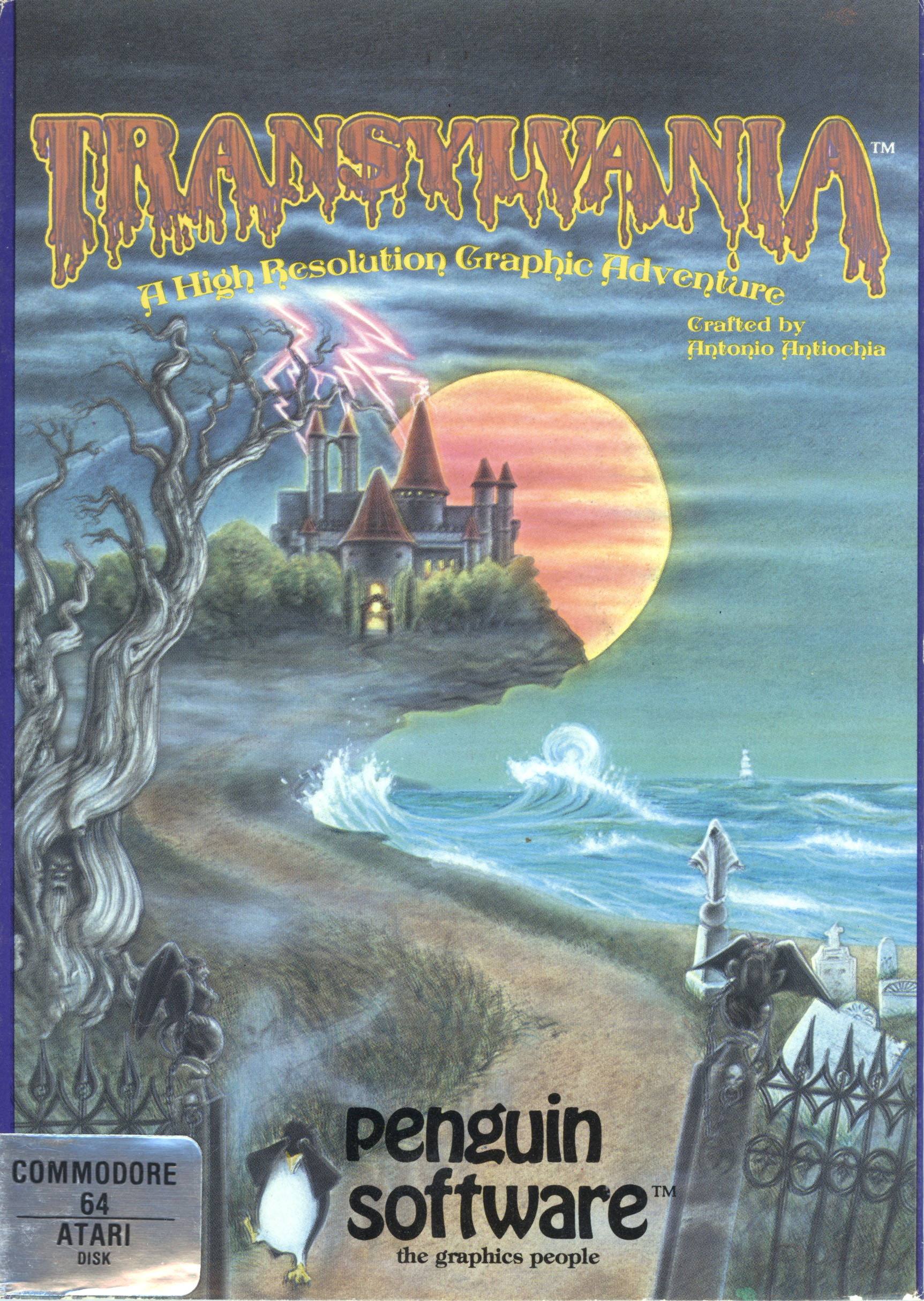
Via the Internet Archive.
(Jimmy Maher was able to interview today’s author, Antonio Antiochia, in detail. Check that link if you’d like to see more.)
Antonio was a 13-year old in 1979 who was at Eastern Michigan University, where his father worked, and was playing with computer terminals in a lab.

A picture of a computer terminal from Eastern Michigan University circa 1978, via the Aurora ’78 yearbook.
He found he could access games with a guest account and came across Adventure, but due to a lack of any starting instructions was unable to get anywhere. (Jimmy mentions in the comments to his post it might have been Wander instead, because of the lack of a tutorial to start. However, Wander was a lot rarer and there were enough ports of Adventure a rogue one could have the instructions cut off.)
The game still stuck in his head and he was able to return later and make progress all the way to the end. He was then out of adventures to play, and while he was already a capable programmer at age 13, he wrote his own on paper rather than on computer.
I came up with dozens of adventure plots in my spare time (and a few other games), drawing their outlines, their maps, etc., based on a wide variety of themes (a bit heavy on the fantasy genre) — simply out of the joy of creativity and discovery. It was cool.
Antonio later learned about Scott Adams games on home computers and the Ann Arbor Community High School Computer Club, so become a regular there. He wrote his own game on an Apple II (Land of Ghaja, now lost) and distributed it the club, then later followed with Transylvania. These were essentially private games.
Rather like with Magic Mirror getting Mr. Antiochia hooked up with a publisher happened by accident. In 1981 his father was calling Mark Pelczarski to order supplies (the store Micro Co-op) when Mark mentioned starting a publishing company (Co-op Software, but eventually Penguin). The elder Mr. Antiochia mentioned his son had written an adventure game, and Mark said to “send it in”.
The game was text-only in BASIC. Since not-yet-Penguin were to be known mostly for their graphical software, it seemed wrong to publish without graphics, but Mark was able to give his own software (including not-yet-released portions) to Antonio. Antonio then spent nearly a year making graphics, and the package of BASIC + graphics + assembly language provided by Penguin was put together into Transylvania.
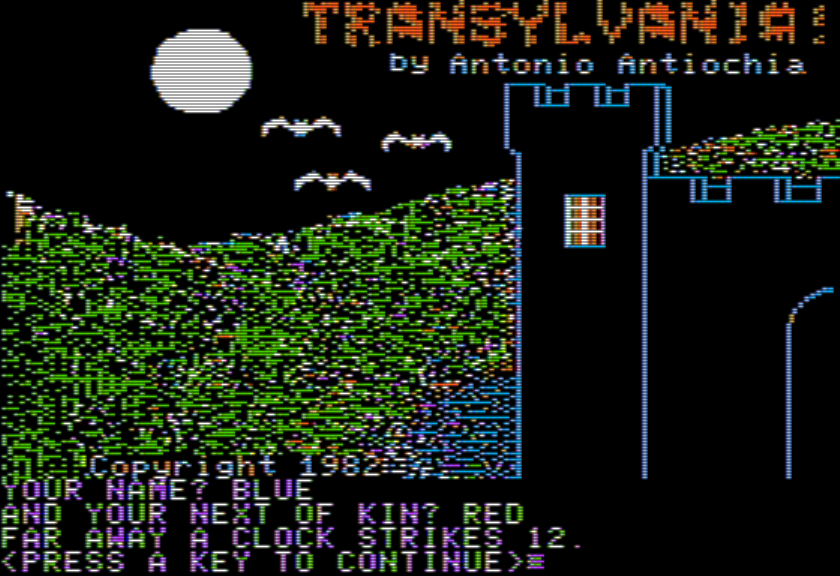
There are incidentally later versions, like a Macintosh black and white version, a “high res” Apple II version, and a larger version with more puzzles published by Polarware. I’m sticking with the 1982 original.
The story begins at midnight, as we have been tasked with the King to rescue the Princess Sabrina, “in the clutches” of a “murderous Vampire”. We have 5 hours.

Reading the stump is a puzzle, as it is “covered with sediment and too fuzzy to read”.
The map is quite open. I was able to get to what I suspect is at least 80% of it from the start, possibly more. There are no locked doors. The puzzles seem to be gating the ability to pick up objects and find information, rather than get into locations.
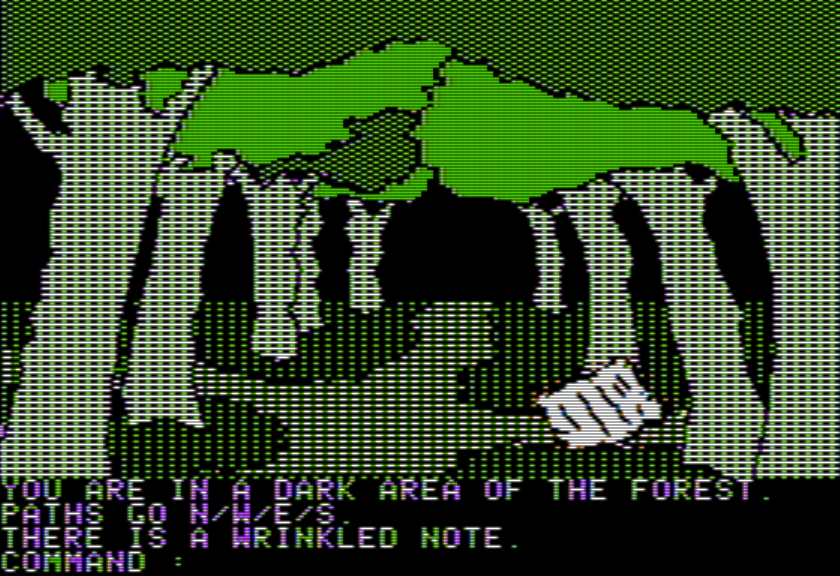
The note says that Sabrina dies at dawn.
Here’s the first part of the map:
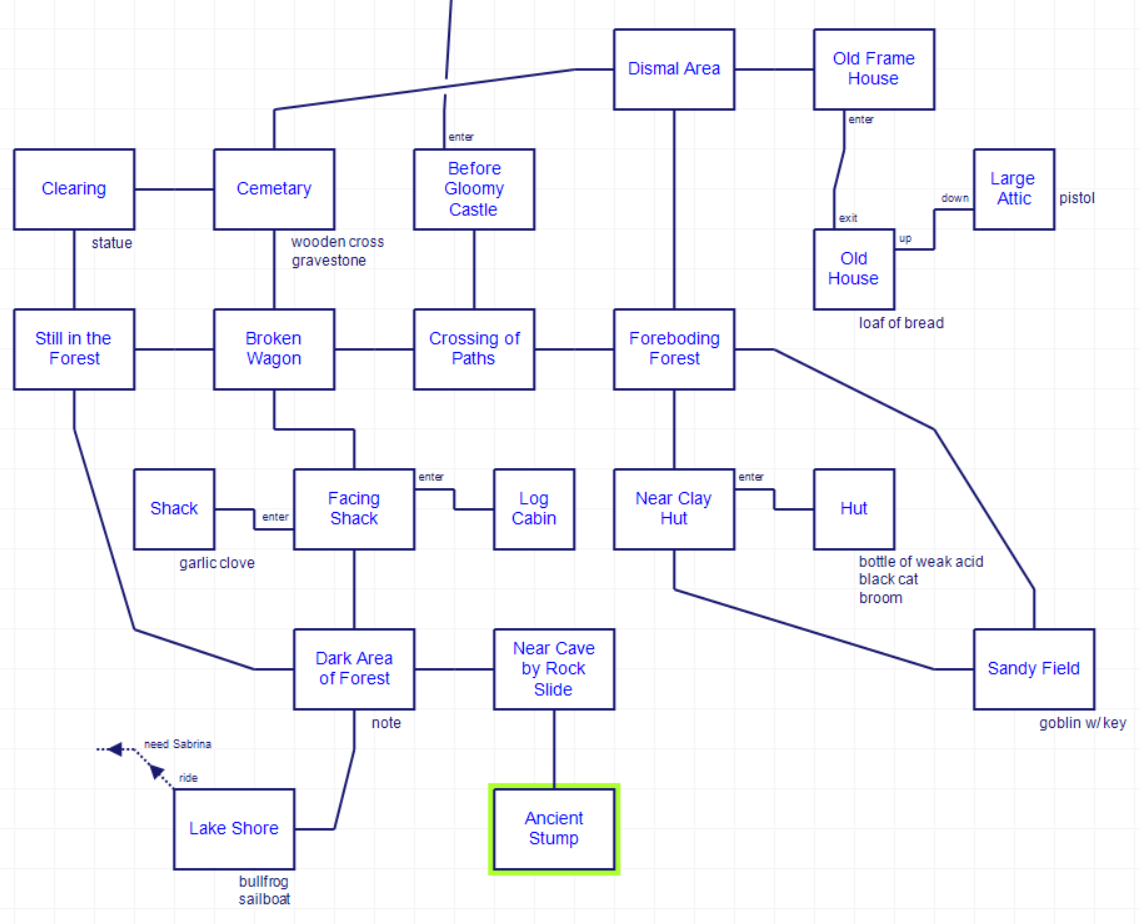
Wandering the map results in a lot of activity, both in terms of sounds and in terms of danger. There might be a “grim chuckle”, or an owl, or the sound of bats.

After a set number of turns (I think?) you start to get chased around by a werewolf. If you pause without running while a werewolf is the room you will die. Sometimes it leaves the trail, but not much. (The closest we’ve had to that effect is Masquerade.) You might additionally get picked up by an eagle and dropped in a random spot, which suggests to me the author was familiar with Hunt the Wumpus in addition to Adventure.

Here both are happening simultaneously.
There’s a “small hut” which is clearly a witch’s house, where a black cat hisses at you if you enter and doesn’t let you take either of the items (a broom and some weak acid; I’m guessing the latter helps with reading the stump).

Of items that can be grabbed just lying around, there’s also a garlic clove, a wooden cross, a stale loaf of bread, and a flintlock pistol in various locations (the latter two in an “Old Frame House”), although the werewolf being present means you can’t pick up an item if it is around.
(Also, the gun is not loaded. I’m guessing we find a silver bullet somewhere for the werewolf.)
For non-movable characters / antagonists, there’s a bullfrog, a goblin with a key (there must be at least one locked thing somewhere) and a admittedly unsettling statue.

Trying to break the statue didn’t work, but maybe I need a particular tool.
The werewolf is restricted to this part of the map, because there’s a castle area to the north that is the domain of the vampire instead.
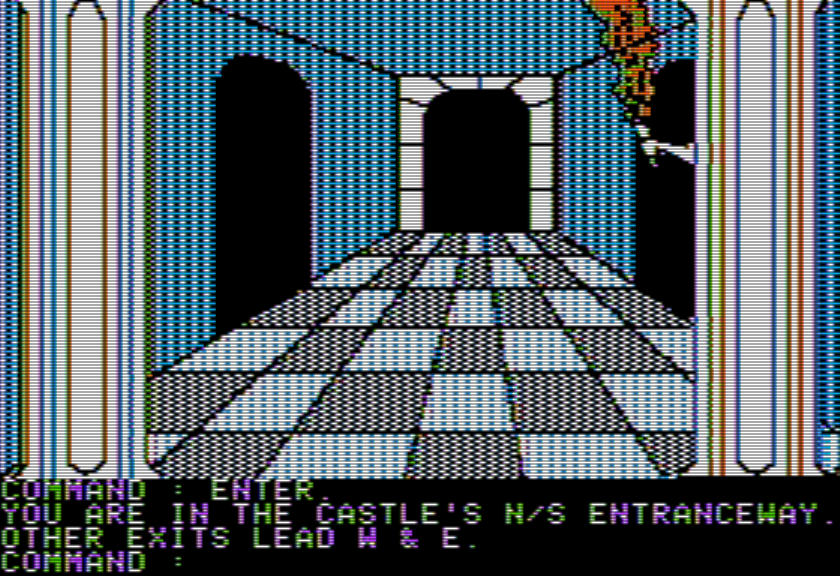
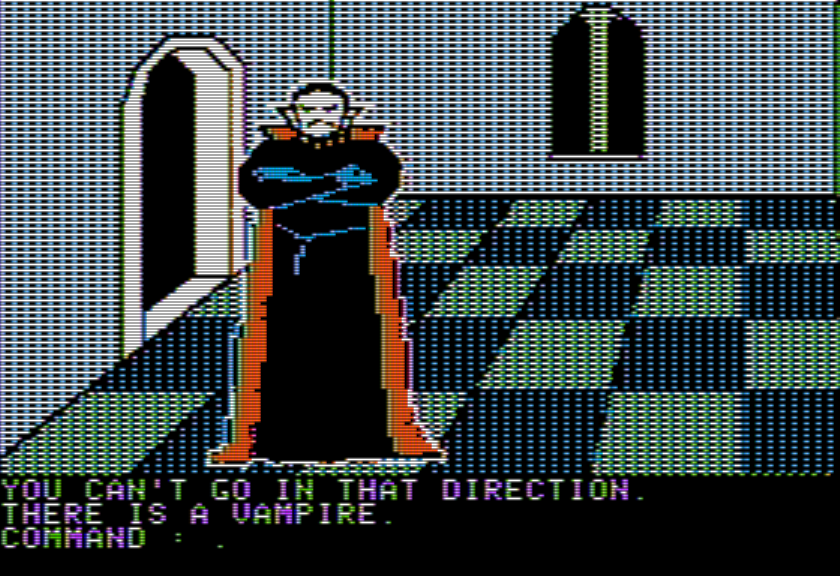
If you are holding the clove of garlic the vampire doesn’t show up at all.
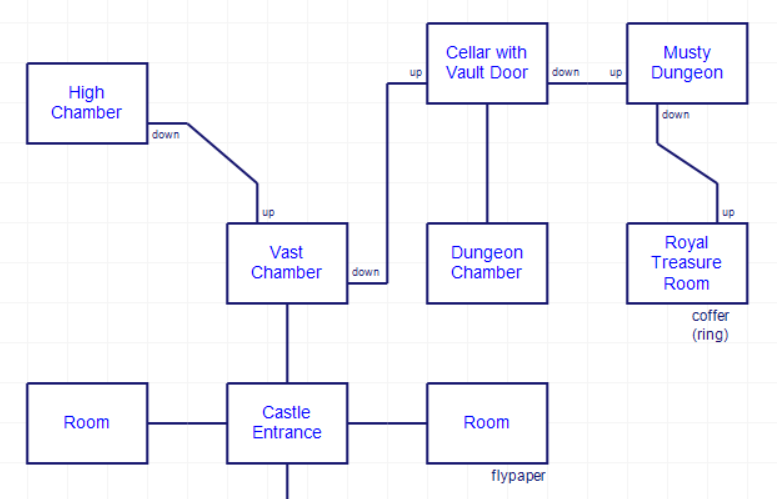
Other than that you can encounter some flypaper (I assume for obtaining a bribe for the bullfrog) and a shiny ring in a coffer, although the ring is protected by a “mysterious barrier”.

I have some ideas I need to test, but the presence of the werewolf makes testing require multiple “runs” (there’s enough time to grab the wooden cross, for instance, but then you have to ignore some other things). This means even if there are no fancy daemons or timers the game isn’t 100% trivial to solve. Mind you, there is an overall timer — death by dawn — so it is possible the timer plays into other events.
Fingers crossed for good progress next time!

There’s a sailboat you can hop into, but it leads you back to “home” and you can’t go home without Sabrina.
Interestingly: I played this on Apple II (I remember having to ask my parents what the “next of kin” line meant), but I’m almost certain it DIDN’T have graphics! (I was very young, and I remember struggling to visualize what was happening from the descriptions…) Maybe the non-commercial version had already been circulating in disk-swapping circles? (Or I might just be misremembering…)
it is possible to have the graphics turned off, but parts of the game are impossible without
there isn’t any text-only version available I (or Jimmy Maher) knows of even though it started that way
i ran through this game and reviewed it a couple years ago. For an earlier 80s graphic adventure game it’s not bad at all.
The quality of the graphics stands out and the puzzle designs are approachable and intuitive.
The werewolf got on my nerves though…
I saw that, hadn’t read it yet to avoid spoilers, but I’ll check when I’m done
this one has enough people play through I might do a meta-review at the end
This one holds a special place in my heart. I had no idea Transylvania was the brain child of another teenager; it’s really quite extraordinary. The gloomy graphics, the ticking clock, the random werewolf encounters, the creepy random flavor text, it all adds up to an experience that felt so much more “alive” than the standard bearer “Hi-Res Adventures”, which felt stodgy by comparison. Especially if you were an 8 year old kid like me with a vibrant imagination, this game was scary and exciting and really, really fun.
It’s always been amazing to me that On-Line Systems were so popular during that era, with their silly crude graphics and insane softlock moon logic puzzles. Their only innovation during that era was “more graphics, more disks” while creative programmers like Antiochia and graphical geniuses like Rick Incrocci were really pushing the limits of what the Apple ][ could do.
I suppose there’s something to be said for all the money they made on Hi-Res Adventures allowing them to fund the development of King’s Quest, but that’s another story for 1984 :)
at least I think this one sold respectably! I mean it is easier to find copies of than Ulysses and the Golden Fleece
Pingback: Transylvania: The Death of a Vampire | Renga in Blue
I wonder if the weak acid is for the statue.